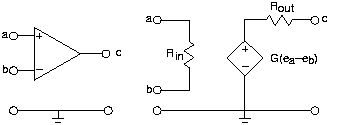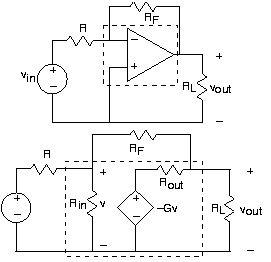| << Chapter < Page | Chapter >> Page > |
A dependent source is either a voltage or current source whose value is proportional to someother voltage or current in the circuit. Thus, there are four different kinds of dependent sources; to describe an op-amp, weneed a voltage-dependent voltage source. However, the standard circuit-theoretical model for a transistor contains a current-dependent current source. Dependent sources do not serve as inputs to a circuitlike independent sources. They are used to model active circuits : those containing electronic elements. The RLC circuits we have been considering so far areknown as passive circuits .

[link] shows the circuit symbol for the op-amp and its equivalentcircuit in terms of a voltage-dependent voltage source.

Here, the output voltage equals an amplified version of thedifference of node voltages appearing across its inputs. The dependent source model portrays how the op-amp works quitewell. As in most active circuit schematics, the power supply is not shown, but must be present for the circuit model to beaccurate. Most operational amplifiers require both positive and negative supply voltages for proper operation.
Because dependent sources cannot be described as impedances, and because the dependent variable cannot "disappear" when you applyparallel/series combining rules, circuit simplifications such as current and voltage divider should not be applied in mostcases. Analysis of circuits containing dependent sources essentially requires use of formal methods, like the node method . Using the node method for such circuits is notdifficult, with node voltages defined across the source treated as if they were known (as with independent sources). Considerthe circuit shown on the top in [link] .

Note that the op-amp is placed in the circuit "upside-down," with its inverting input at the top and serving as the onlyinput. As we explore op-amps in more detail in the next section, this configuration will appear again and again and its usefulness demonstrated. To determine how the output voltage is relatedto the input voltage, we apply the node method. Only two node voltages— and —need be defined; the remaining nodes are across sources or serve as the reference. The node equations are

Notification Switch
Would you like to follow the 'Fundamentals of electrical engineering i' conversation and receive update notifications?